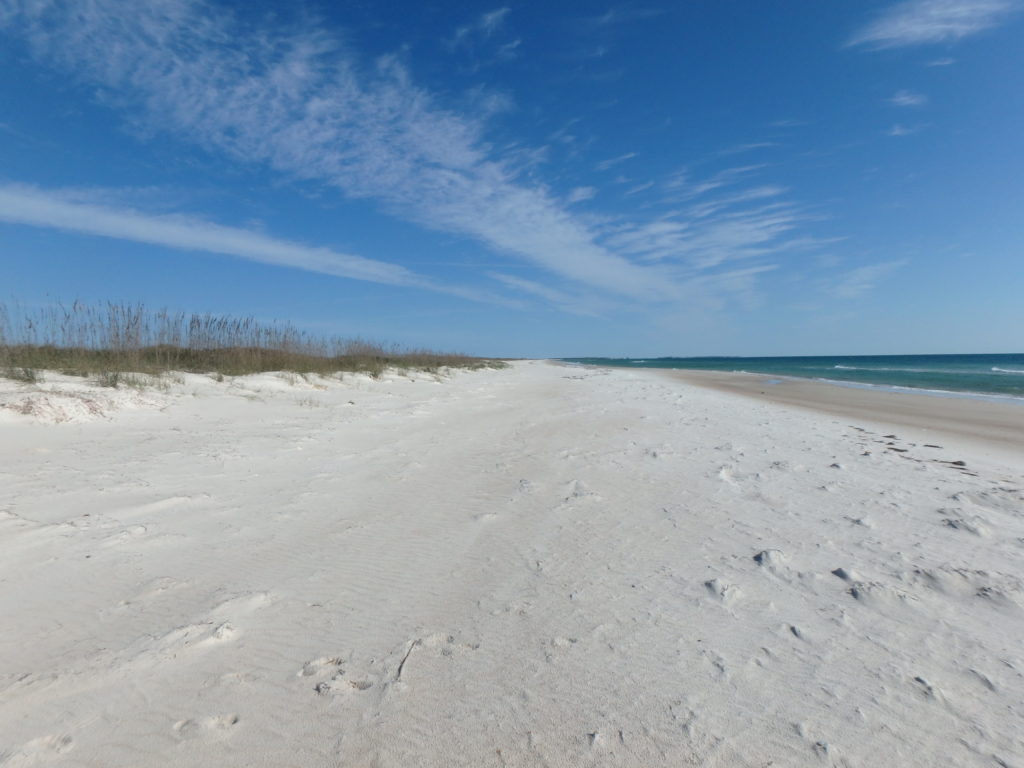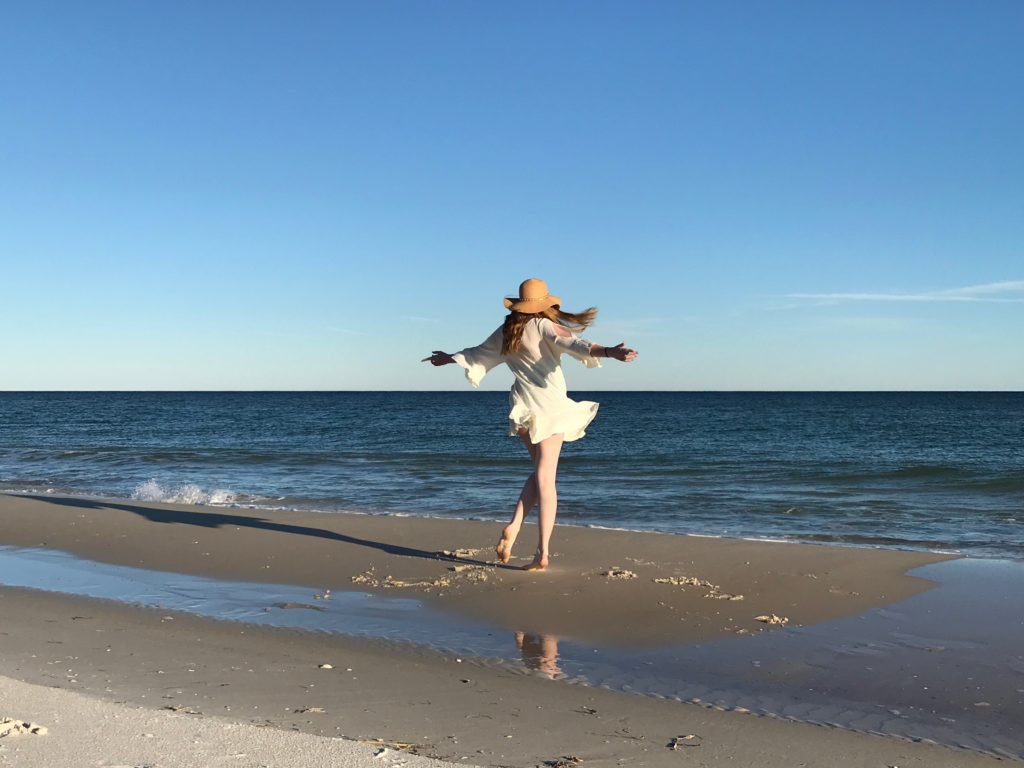10 Things To Do on St. George Island
It’s camping season again for us in Florida and that means a chance to explore more of our beautiful state parks. We recently visited St. George Island and had an excellent time camping at Dr. Julian G. Bruce St. George Island State Park. This is along what is called “The Forgotten Coast” of Florida but it has much to offer so we will definitely remember it. Our nearly 7-hour road trip up into the Florida panhandle led us to the Coastal Trail of the Scenic Big Bend Byway along the Gulf of Mexico before crossing the third longest (4-mile) bridge in Florida to St. George Island.
We had 3 full days (4 nights) on the island and felt like we packed in a lot in that short time. It’s so good to get away and unplug – we really should do it more often! Here, in no particular order, is our list of top ten family-friendly (and budget-friendly) things to do on and near St. George Island:
1 Take a night hike to stargaze on the beach
We were fortunate to arrive on the day of the new moon so that, combined with the fact that we were in a state park several miles out into the Gulf of Mexico and away from light pollution, meant that the nighttime views of the sky were amazing! The cloudless sky let us see so many constellations, plus we were treated to a show of shooting stars as our trip coincided with the Leonid meteor shower – how fortunate was that?! You don’t have to know Cassiopeia from Seven Sisters to appreciate the night sky out here. We lay down on our backs on one of the beach boardwalks for a relaxing and fascinating celestial view coupled with the soothing sounds of waves crashing gently on the shore. Unfortunately, I was not prepared to even try to photograph the Milky Way – disappointing, huh? – so the only photo I have to share of this particular adventure was of one of the island’s many crabs who scurried by us on our stargazing adventure.

2 Bike among the island’s sand dunes
This is a 28-mile-long island that in some areas is so narrow that you can see both the Gulf and the bay sides. At the east end of the state park, you’ll find a gate across the road. To drive beyond this point, you need to pay a small fee back at the ranger station, but cyclists and pedestrians can pass for free. We had brought our bikes so we rode the 5 miles along the primitive road among the sand dunes to the end of the island (10 miles round trip), spotting a snake, crabs, and a variety of shorebirds along the way. More than anything though, there were the butterflies! So many butterflies all over this island! Once we got to the end, we walked a bit of the beautiful white-sand beach on both the bay and Gulf sides while watching dolphins play not far from shore.

3 Hike out to Gap Point
Whether you start from the Nature Trail at the far side of the campground or from the boardwalk at East Slough, you can hike approximately 2.5 miles out to Gap Point. This section of the island has much more vegetation than the dunes we biked through before so the change of scenery from sparse sand dunes to pine forest was interesting.


And again, Monarch and Painted Lady butterflies everywhere! We even found several single butterfly wings scattered around our campsite so I think the birds may feast on them quite a bit…

Once at Gap Point, you can walk out quite far among the pools of shallow water, spotting horseshoe crabs.

4 Go fishing
What better place to go fishing than an island, right? Bay side or the Gulf, from the beach or a bridge, the opportunities are plentiful. You can find bait and tackle all over the island and even if you don’t really know what you’re doing (ahem), and you release anything you do manage to catch, and you might feed the fish waaay more than you catch them, you can have a great time. And if you’re not into fishing, you can do what my daughter did, and simply bring your knitting and bask in the sun on the rocks.

5 Visit the Cape St. George Lighthouse
St. George Island hasn’t had the best of luck with their lighthouses, to be honest. From being built in the wrong location, to toppling into the sea, they finally got it right with this reconstruction. To be fair, these lighthouses do have to withstand hurricanes and storm surges. Although the government was ready to let the fallen lighthouse become a reef, the locals wouldn’t have it. Volunteers reclaimed and cleaned thousands of bricks from the lighthouse that collapsed into the sea and incorporated them into the new lighthouse which opened to the public in 2008 and is now on the historical register. The very kind lady there shared some really interesting information about the history of the lighthouses on St. George with us and it was well worth looking around before heading to the lighthouse itself.
It takes fewer than 100 steps, plus an 8-rung ladder through a narrow opening, to get to the very top. Here my 6-year-old climbs her way to the top.

Once there, we soaked in the 360-degree views of the island, including dolphins playing just off shore not far from several kayakers. We can never get enough of the dolphins!

6 Rent a paddleboard
Of course, water sports are big on an island and since we kayaked just last weekend, we thought we’d try something different. For $50 per board for 4 hours, we rented two and headed to a spot near the bridge where the kids and I ventured out and about. Even my 6-year-old successfully balanced on the front of the board paddled by her older brothers. Happily, no one fell in and we all had fun! I especially liked that it was a gentle paddle out and then the breeze brought us straight back to shore with virtually no effort, just a chance to float and breathe in the sea air!

7 Walk along the white sandy beaches
The kids wanted to dig in the sand and I happily let them do their thing while I walked up and down the shore once again breathing in that salt air, side-stepping the occasional beached jellyfish, and watching the Snowy Plovers race along the water’s edge. A sign at one of the pavilions warned visitors not to feed the sea gulls because they ate Snowy Plover babies. Ack! If you’re into shelling, there aren’t many unusual shells here, though there are a few pretty ones of the common varieties. I noticed a number of sand dollar fragments but none that were intact. On our last night, we had some weather come in which made for stunning and colorful skies on our beach walk.


8 Explore the ANERR Nature Center
You’ll have to cross back to the mainland for this one, but it is well worth it. It’s just on the other side of the bridge, it’s FREE, and it is an amazing source of information. The Apalachicola National Estuarine Research Reserve (ANERR) Nature Center features three aquaria representing the Gulf, the Bay and the Rivers, many jars of preserved animal specimens, an impressive collection of shells and fossils, and engaging stories of the oyster and other fishing industries so important to this region. We really enjoyed it.

The Nature Center also features several short and enjoyable boardwalk trails. It was interesting to read about the oyster industry inside and then find binoculars at the end of the Bay Overlook boardwalk and literally see a dozen oyster boats out there with men culling oysters using the same tools that have been used for many decades.

9 Venture into Tate’s Hell
We couldn’t resist a drive into Tate’s Hell State Forest after hearing the legend of the poor man for whom this area is named. As with all good local legends, there are some variations of the story but it boils down to a frustrated farmer in the 1800s, Cebe Tate, heading into the unforgiving environment with his dogs and his gun to take down a panther that had been harming his livestock (or, in another version, to find scrub cattle because his mail-order bride from New York, who was Jewish, refused to eat the family’s pigs and demanded beef).
Either way, it didn’t work out well for him. The panther got his dogs, he got hopelessly lost, he was tormented by the skeeters and bitten by a venomous snake, leading to illness and delirium. More than a week passed before he finally stumbled out of the swamp some 25 miles from his homestead only to utter the words “My name is Cebe Tate and I’ve just come from hell” and the swamp has been named Tate’s Hell ever since.

We had really hoped to see a bear in this area but sadly, that was not to be, although I have a feeling half a dozen bears probably spotted us. We made our way along the bumpy deserted dirt roads to Kendrick Dwarf Cypress Boardwalk, a short boardwalk that leads out over a very unique stand of dwarf cypress trees. Many of them are several hundred years old but grow only to a height of about 6 feet. Interestingly, information I received at the ANERR Nature Center states that “No one is exactly sure what causes the cypress in this area to be dwarfed. The trees are not genetically different from other pond-cypress trees in the area, and seeds from these trees will grow to normal heights when planted on other sites.” A variety of environmental factors may be at play here, but it’s an interesting sight either way. We were here in November but I’d be curious to see the area in spring.

We spotted a water moccasin basking unmovingly on a low branch at the base of the boardwalk, reminding us that we were indeed in Tate’s Hell. And by the looks of it, locals still venture into the swamp with their guns and shoot up all the signs…

10 Enjoy the local food
Most of our meals were made at camp, apparently under the eager gaze of the local squirrels. Shortly after one lunch, when we had all stepped into our pop-up camper with items to help clean up, we noticed a quick thief making off with a leftover sandwich. It was quite a sight!

There was one exception to our camp food: we treated ourselves to a nice restaurant meal at the end of a busy day. There are very few places to choose from (three?) but either way, you’ll be just steps from the beach, with a view of the setting sun and a plate of deliciously fresh seafood. It was wonderful to not have to cook! The skies are dramatic here.



Of course, a walk or drive around the small town and down the east section of the island to admire all the houses on stilts is a must. We were told at the visitor center that some of these homes rent for as much as $10,000 per week! The western section of the island remains a mystery to us as it consists of a private, gated, and apparently highly exclusive residential community (which even has its own airstrip). I understand some of the most expensive multi-million-dollar beach homes along the Gulf of Mexico are found here, but alas, we did not get past the gates…
We chose the more budget-friendly option for enjoying St. George Island, namely camping at the state park…. No regrets!
